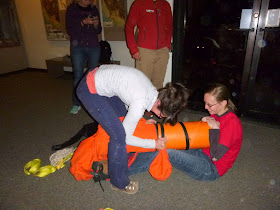May 20-22, 2016 was the Centennial Bird BioBlitz at Great Basin National Park. Over the course of three days, 150 people gathered to learn about and help document the birds in the park. The BioBlitz started off Friday with an afternoon of workshops.
Joe Doucette from the Nevada Department of Wildlife brought Hedwig the owl. He was a big hit.
Later, Ranger Mark showed the audience how to whistle and make various bird songs. It was really cool. Every time I hear a nighthawk now, I think of his "Beans" imitation.
Past artists-in-residence for Great Basin National Park, Miki Herder and Kristin Gjerdset, attended and led bird illustration workshops.
About 35 school kids attended and did their best to draw an owl. Some of them had amazing drawings.
It wasn't all birds--we also had a talk about bird food, aka reptiles. The kids (and adults) loved seeing specimens up close.
The next morning there were nine different bird walks to choose from. I joined one near the visitor center. I didn't think we would see that much in the pinyon juniper.
Boy, was I wrong. We found 17 species, including this green-tailed towhee.
Then I joined a walk up South Fork Baker Creek. It was a much bigger crowd, as it started later in the day.
We saw beautiful scenery, but not quite as many birds. However, a goshawk flew over the group, so that was super exciting.
You can tell that people are into their hobby when their license plate reflects it!
The afternoon included more talks and demonstrations. Martin Tyner from Southwest Wildlife Foundation showed several birds, including this falcon
The golden eagle was really big.
The second bird illustration workshop was a little smaller, allowing each attendee to get some personalized attention.
The kids enjoyed drawing more.
On Sunday morning I joined another bird walk. As you can see by the clothing, it was a little cool.
I happened to be taking a photo of the group when a bird was spotted behind me. I couldn't resist snapping a photo of the birders!
I did photograph a few birds, like this mountain bluebird.
This Say's phoebe was taking some lunch to the nest.
The BioBlitz concluded with a lunch sponsored by the Great Basin National Park Foundation.
Following the lunch, we learned the preliminary results from Kelly Colegrove of Great Basin Bird Observatory. Over 70 species had been tallied, with data still needing to be entered.

Then it was time for some raffle prizes donated by the Western National Parks Association.
One last thing--a group photo!
It was a very fun event, and now the park knows more about what birds live or visit there in May.

























































